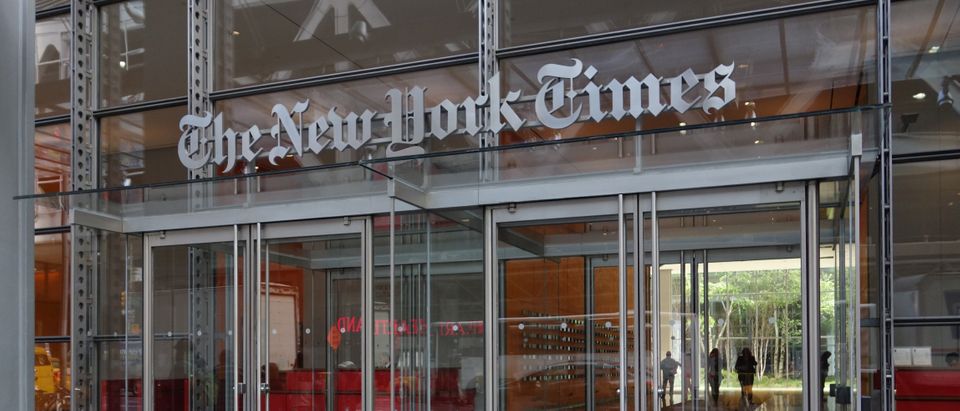Trust in the media has dropped off dramatically, and while there are those who claim that former President Donald Trump’s constant cries of “fake news!” are to blame, there are a number of factors to consider.
Trust In ‘Traditional Media’ Hits All-Time Low In America https://t.co/FtBFEiUEC5
— Daily Caller (@DailyCaller) January 21, 2021
Not the least among those factors is the fact that media occasionally gets the story wrong — sometimes because the desire to break a story first outweighs the desire to get it right and sometimes because the information being reported comes from sources that are not trustworthy.
“Why is trust in traditional media at an all time low?!?!?!” pic.twitter.com/Qn3qTVkdJ4
— Daily Caller (@DailyCaller) January 21, 2021
Still can’t seem to figure out why trust in traditional media might be at an all time low ????♂️pic.twitter.com/P3W7b9ysXz
— Daily Caller (@DailyCaller) January 21, 2021
Investigative reporter Sharyl Attkisson put together a comprehensive list of 151 media mistakes, all of which were stories about Trump or members of his administration. That list included:
- Oct. 1, 2016: several outlets claimed that Donald Trump had not paid taxes for nearly two decades. When several pages of his tax return were leaked to MSNBC two years later, they proved that Trump had not only paid taxes, but that he had done so at a higher rate than former President Barack Obama and independent Vermont Sen.Bernie Sanders.
- Jan. 20, 2017: TIME’s Zeke Miller reported that the bust of Martin Luther King, Jr. had been removed from the Oval Office as Trump moved in. The story was corrected, but not before it went viral.
- June 22, 2017: CNN reporter Thomas Frank and two others at CNN resigned after a story claiming the Congress was investigating a “Russian investment fund with ties to Trump officials” had to be retracted.
- Dec. 8, 2017: CNN’s Manu Raju and Jeremy Herb misreported the date of Donald Trump Jr’s contact with WikiLeaks, making it appear as though he had spoken to the organization prior to email dumps that were damaging to former Secretary of State Hillary Clinton and other Democrats. The story was lated corrected to show that the contact occurred after the email’s were made public.
Another major story that many got wrong involved a group of students from Covington Catholic High School in Kentucky who attended 2019’s March for Life.
A viral video took social media by storm and appeared to show a teenaged boy in a MAGA hat smirking in the face of a Native American activist. The initial captions and stories suggested that the boy, identified as Nick Sandmann, was mocking Elder Nathan Phillips — but a full video that was released later showed that Phillips had approached Sandmann intentionally, and that Sandmann and his fellow students had done nothing to provoke him. (RELATED: The Real Story Behind The Catholic School Boys And Their Dust Up With A Native American Veteran)
But those weren’t the only media missteps in recent years — and there were plenty of errors that had nothing to do with Trump. Reporting on the coronavirus pandemic alone has gone down a series of rabbit holes, especially as the search for the pandemic’s origin took shape.
While early reports tied the virus to a wet market, rumors quickly spread that it had originated in a lab and then leaked, perhaps due to the actions of a careless employee not observing safety protocols.
The U.S. Intelligence Community quickly confirmed that such leaks were under investigation, but a number of media outlets just as quickly reported the opposite. The Los Angeles Times suggested that reports of a lab leak had “all the earmarks of a conspiracy theory.” Nature Medicine journal also dismissed the idea that the virus had come from a lab, as did The Washington Post.
But months later, as more and more reports began to suggest that the lab-leak theory wasn’t as conspiratorial as some had said, the story has begun to regain some of the traction it lost. (RELATED: US Has Evidence Researchers In Wuhan Lab Fell Ill Before Coronavirus Outbreak, State Department Says)
The media’s pivot to a very different kind of coverage as President Joe Biden took office may not help with any credibility issues, either.
A Washington Post story was retroactively edited — several months after publication — to remove an anecdote about Vice President Kamala Harris that did not paint a flattering picture.
The Washington Post’s 2019 profile of Kamala Harris and her sister Maya contained an incredibly cringe-worthy scene in which Harris seemed to mock inmates and compared the difficulties of campaigning to life in prison.
It was awful.
And now it’s gone.https://t.co/F8LioFu3WM
— Eric Boehm (@EricBoehm87) January 22, 2021
Legacy media has a trust problem right now — lots of Americans seem to believe that “the media” is playing for one political team. Editorial decisions like this one, even if unintentional, feed into that perception.https://t.co/F8LioFu3WM
— Eric Boehm (@EricBoehm87) January 22, 2021
And the media may have a hard time rebuilding that trust. Press briefing questions addressing the color scheme on Air Force One — and a tweet from CNN White House correspondent John Harwood — have done little to dispel concerns that the media might be taking sides with the Biden administration.
. @jrpsaki is asked if Biden will keep Trump’s paintjob for the new Air Force Once planes (left) or revert to the current look on the existing planes (right). She says she doesn’t know but will poke around. pic.twitter.com/5CqaIs9JGk
— Josh Wingrove (@josh_wingrove) January 21, 2021
Trump—>Biden
lies—>truth
ignorance—>knowledge
amorality—>decency
cruelty—> empathy
corruption—>public service— John Harwood (@JohnJHarwood) January 20, 2021












